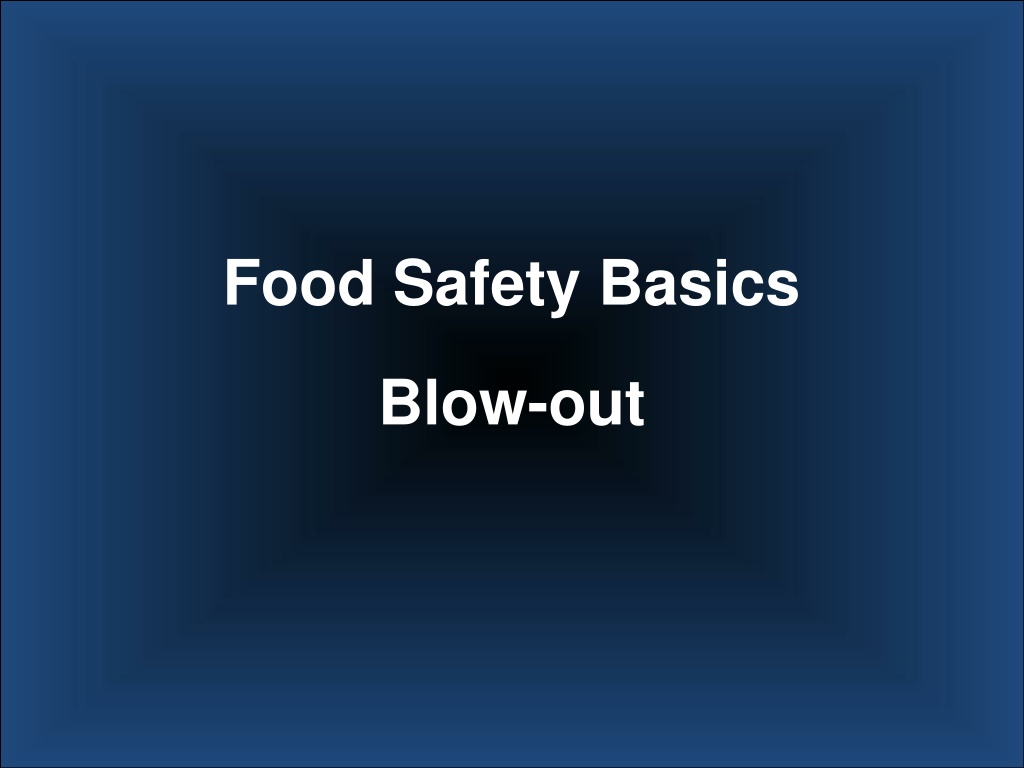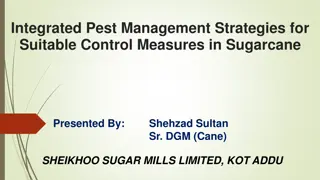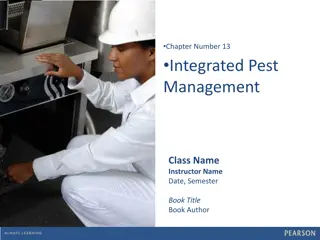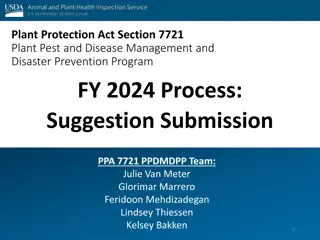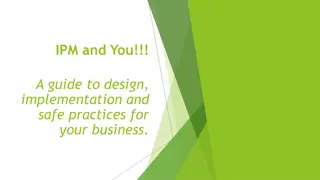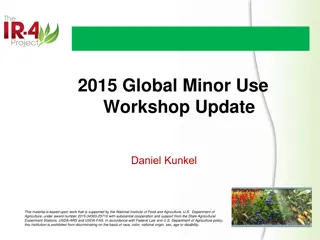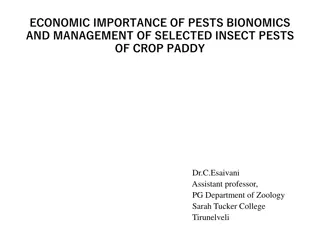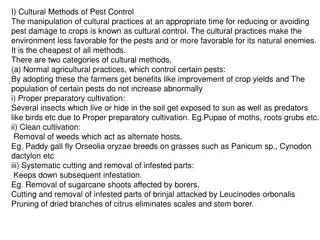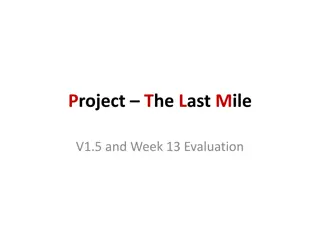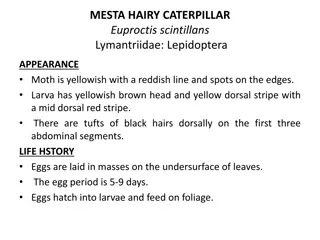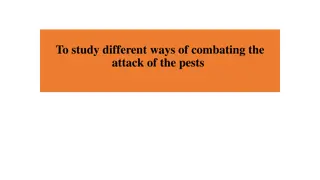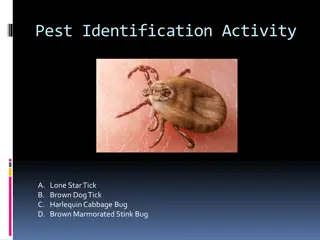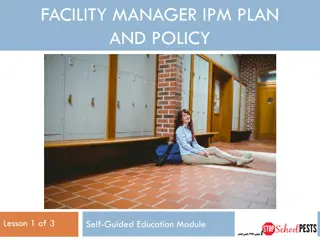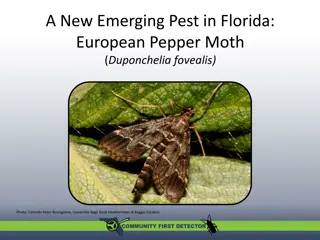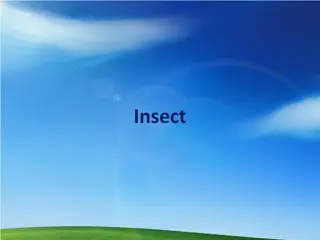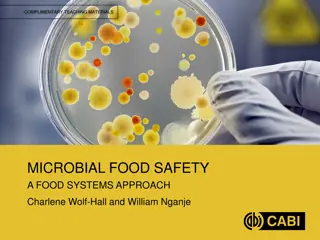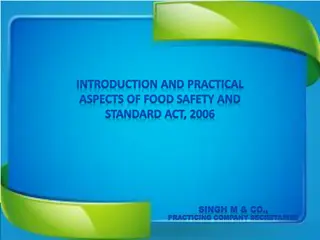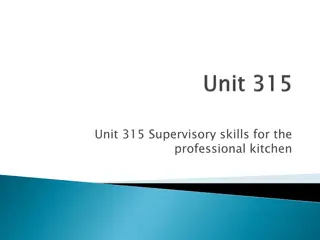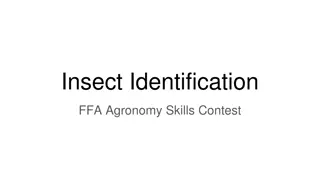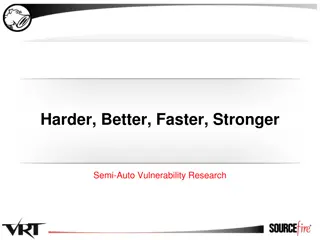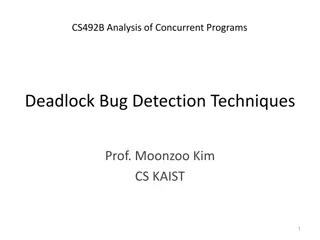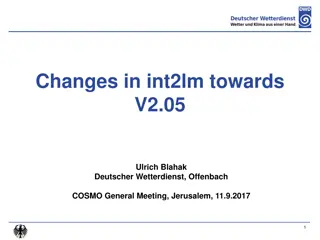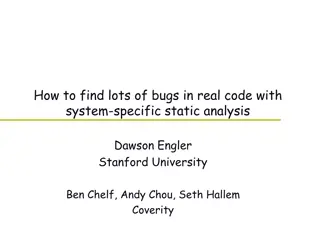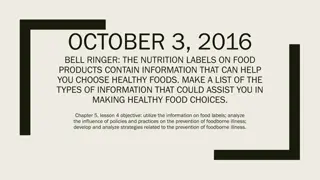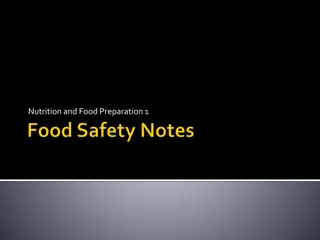Food Safety Basics Blow-out: Don't Bug Me, You Pest!
Explore important food safety basics through engaging quizzes and images. Learn about common insect pests, their identifying features, and prevention methods to ensure a clean and safe food environment. Discover why house flies are called filth flies and the essential elements of a comprehensive pest-control program.
Download Presentation

Please find below an Image/Link to download the presentation.
The content on the website is provided AS IS for your information and personal use only. It may not be sold, licensed, or shared on other websites without obtaining consent from the author. Download presentation by click this link. If you encounter any issues during the download, it is possible that the publisher has removed the file from their server.
E N D
Presentation Transcript
Food Safety Basics Blow-out
Food Safety Basics Blow-out Don t get busted by the FBI 100 Don t bug me, you pest Take a sip of HACCP Go with the (food) flow Clean it! Sanitize it! 100 100 100 100 100 100 100 100 100 200 200 200 200 200 200 200 200 200 200 300 300 300 300 300 300 300 300 300 300 400 400 400 400 400 400 400 400 400 400 500 500 500 500 500 500 500 500 500 500 Bonus question 1 Bonus question 2 Bonus question 1 Points x2 Bonus question 2 Points x3 Points x2 Points x3
Dont bug me, you pest Which insect pests are light brown, of an inch long and produce an oily musty smell if there are enough of them? 100 100
German cockroaches Back to questions Back toquestions
Dont bug me, you pest What three things attract pests to food premises and encourage them to stay? 200 200
Food, shelter and water Back to questions Back toquestions
Dont bug me, you pest My snout is blunt, I burrow in the ground, I can climb straight up a brick wall and squeeze through a hole the size of a quarter. I have a weak bladder and dribble urine on food-contact surfaces. What am I? 300 300
A Norway rat Back to questions Back toquestions
Dont bug me, you pest Why are house flies also known as filth flies ? 400 400
Because they vomit and poop on food and lay eggs in fresh fecal matter Back to questions Back toquestions
Dont bug me, you pest Good housekeeping, good sanitation, a combination of chemical and non-chemical pest-control methods and good communications with the PCO are all elements of which type of pest-control program? 500 500
Integrated Pest Management (IPM) Back to questions Back toquestions
Take a sip of HACCP What do the letters HACCP stand for? 100 100
Hazard Analysis Critical Control Point Back to questions Back toquestions
Take a sip of HACCP Name two CCPs that have a critical limit of 165 F. 200 200
Cooking poultry Re-heating TCS food Cooking TCS food in a microwave Cooking combined or stuffed TCS food Back to questions Back toquestions
Take a sip of HACCP Taking the temperature of food, checking hot-holding temperatures, testing the strength of sanitizing solutions and checking the ambient temperature of a walk-in cooler are all examples of which type of HACCP activity? 300 300
Monitoring a CCP Back to questions Back toquestions
Take a sip of HACCP If, after six hours in a walk-in cooler, a container of cooked rice is found to be 80 F, what corrective action must be taken? 400 400
The rice must be discarded Back to questions Back toquestions
Take a sip of HACCP Give two examples of SOPs that support the HACCP plan. 500 500
Personal hygiene, pest control, or cleaning and sanitizing program Back to questions Back toquestions
Go with the (food) flow A food handler has been asked to stop his prep work to receive a delivery. What must he do before receiving any supplies and before returning to his prep work? 100 100
Wash his hands Back to questions Back toquestions
Go with the (food) flow What specific requirement makes thawing TCS food in a microwave different from thawing it in a walk-in cooler or under cold, running water? 200 200
It must be part of the continuous cooking process Back to questions Back toquestions
Go with the (food) flow The FDA Food Code says to store cooked/RTE food over raw in the cooler. List the best practice order of storing raw poultry, raw beef, raw ground meats, fish, cooked/RTE, and raw pork? 300 300
Cooked/RTE Fish Raw beef Raw pork Raw ground meats Raw poultry Back to questions Back toquestions
Go with the (food) flow State the minimum internal cooking temperatures for at least three different TCS foods. 400 400
145 F for whole cut steak 145 F for fish 145 F for pork chops 155 F for ground beef 165 F for poultry Back to questions Back toquestions
Go with the (food) flow Plastic packages of frozen roast beef have been delivered in a cardboard box. What signs or conditions could indicate that the roast beef has been allowed to thaw and then refreeze? 500 500
Large ice crystals inside the packaging Water marks on the cardboard box A sagging cardboard box Back to questions Back toquestions
Dont get busted by the FBI Give an example of how food could become contaminated with a toxin. 100 100
Sneezing on RTE TCS food Handling RTE TCS food with an open sore on a hand Spilling cleaning solution on RTE TCS food Back to questions Back toquestions
Dont get busted by the FBI Salmonella is anon-spore-forming bacterium that is commonly associated with which foods? 200 200
Poultry and eggs Back to questions Back toquestions
Dont get busted by the FBI Name at least three common symptoms of a food-borne illness? 300 300
Vomiting Diarrhea Abdominal cramps Headache Back to questions Back toquestions
Dont get busted by the FBI Bacillus cereus, Clostridium botulinum and Clostridium perfringens are all spore-forming bacteria. How do sporescause food-borne illness? 400 400
Spores form when conditions become unfavorable. Spores are dormant but when the conditions improve (when food is left in the TDZ) they become active again and can restart the process of bacterial multiplication, leading to harmful levels of bacteria or the production of toxins in food that can cause illness. Back to questions Back toquestions
Dont get busted by the FBI E. coli O157:H7 is a non-spore-forming bacterium that is most commonly associated with ground beef, but has been linked to raw spinach, raw unpasteurized milk and fruit juices. What is the most common source of E. coli contamination? 500 500
Poop/fecal material and untreated sources of water Back to questions Back toquestions
Clean it! Sanitize it! Clean means to be free of visible soil and debris. Sterile means to be free of all living micro-organisms. What is the meaning of the term sanitary ? 100 100
Free of harmful levels of pathogens Back to questions Back toquestions
Clean it! Sanitize it! What are the correct concentration levels for a sanitizing solution containing each of the following: iodine, chlorine and quats? 200 200
Iodine 12.525 ppm Chlorine 50 100 ppm Quats 200 ppm (except for products that allow for range per manufacturer's guidelines) Back to questions Back toquestions
Clean it! Sanitize it! For manual warewashing, should the three- compartment sink be set up from right to left or from left to right? 300 300
It doesnt matter, as long as the correct order is followed i.e. PWRSA: 1. Pre-wash 2. Wash 3. Rinse 4. Sanitize 5. Air dry Back to questions Back toquestions
Clean it! Sanitize it! When using a high temperature dish machine, what is the proper concentration level for a chemical sanitizer? 400 400
There is no need to use a chemical sanitizer with a high temperature dish machine. The temperature of the hot water is enough to sanitize and would break down chemical and/or cause it to evaporate. Back to questions Back toquestions
